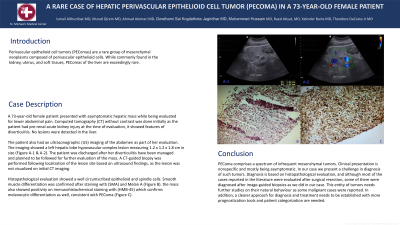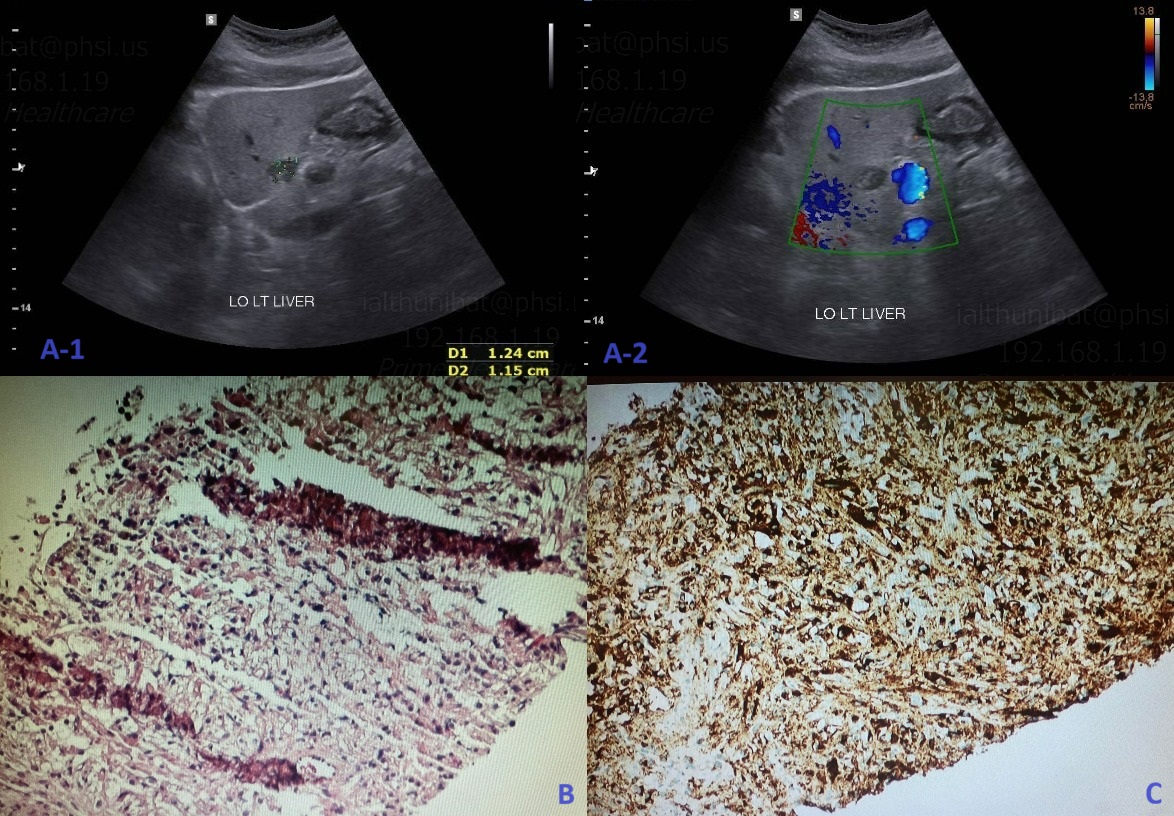Monday Poster Session
Category: Liver
P3004 - A Rare Case of Hepatic Perivascular Epithelioid Cell Tumor (PEComa) in a 73-Year-Old Female Patient
Monday, October 28, 2024
10:30 AM - 4:00 PM ET
Location: Exhibit Hall E

Has Audio

Ismail Althunibat, MD
Saint Michael's Medical Center
Newark, NJ
Presenting Author(s)
Ismail Althunibat, MD1, Murad Qirem, MD2, Ahmad Alomari, MD3, Gowthami Sai Kogilathota Jagirdhar, MD4, Muhammad Hussain, MD2, Yatinder Bains, MD2, Raed Atiyat, MD2, Theodore DaCosta Jr, MD2
1Saint Michael's Medical Center, Newark, NJ; 2New York Medical College - Saint Michael's Medical Center, Newark, NJ; 3Henry Ford Hospital, Detroit, MI; 4Saint Michaels Medical Center, Newark, NJ
Introduction: Perivascular epithelioid cell tumors (PEComas) are a rare group of mesenchymal neoplasms composed of perivascular epithelioid cells. While commonly found in the kidney, uterus, and soft tissues, PEComas of the liver are exceedingly rare.
Here we present a rare case of incidentally found PEComa of the liver which is an extremely rare case as few similar cases have been reported in the litreture.
Case Description/Methods: A 73-year-old female patient presented with asymptomatic hepatic mass while being evaluated for lower abdominal pain. Computed tomography (CT) without contrast was done initially as the patient had pre-renal acute kidney injury at the time of evaluation, it showed features of diverticulitis. No lesions were detected in the liver.
The patient also had an ultrasonographic (US) imaging of the abdomen as part of her evaluation. The imaging showed a left hepatic lobe hypovascular complex lesion measuring 1.2 x 1.2 x 1.8 cm in size (Figure A-1 & A-2). The patient was discharged after her diverticulitis have been managed and planned to be followed for further evaluation of the mass. A CT-guided biopsy was performed following localization of the lesion site based on ultrasound findings, as the lesion was not visualized on initial CT imaging.
Histopathological evaluation showed a well circumscribed epithelioid and spindle cells. Smooth muscle differentiation was confirmed after staining with (SMA) and Melan A (Figure B). the mass also showed positivity on immunohistochemical staining with (HMB-45) which confirms melanocytic differentiation as well, consistent with PEComa (Figure C).
Discussion: PEComa comprises a spectrum of infrequent mesenchymal tumors. Clinical presentation is non-specific and mostly being asymptomatic. In our case we present a challenge in diagnosis of such tumors. Diagnosis is based on histopathological evaluation, and although most of the cases reported in the literature were evaluated after surgical resection, some of them were diagnosed after image-guided biopsies as we did in our case. This entity of tumors needs further studies on their natural behaviour as some malignant cases were reported. In addition, a clearer approach for diagnosis and treatment needs to be established with more prognostication tools and patient categorization are needed.

Disclosures:
Ismail Althunibat, MD1, Murad Qirem, MD2, Ahmad Alomari, MD3, Gowthami Sai Kogilathota Jagirdhar, MD4, Muhammad Hussain, MD2, Yatinder Bains, MD2, Raed Atiyat, MD2, Theodore DaCosta Jr, MD2. P3004 - A Rare Case of Hepatic Perivascular Epithelioid Cell Tumor (PEComa) in a 73-Year-Old Female Patient, ACG 2024 Annual Scientific Meeting Abstracts. Philadelphia, PA: American College of Gastroenterology.
1Saint Michael's Medical Center, Newark, NJ; 2New York Medical College - Saint Michael's Medical Center, Newark, NJ; 3Henry Ford Hospital, Detroit, MI; 4Saint Michaels Medical Center, Newark, NJ
Introduction: Perivascular epithelioid cell tumors (PEComas) are a rare group of mesenchymal neoplasms composed of perivascular epithelioid cells. While commonly found in the kidney, uterus, and soft tissues, PEComas of the liver are exceedingly rare.
Here we present a rare case of incidentally found PEComa of the liver which is an extremely rare case as few similar cases have been reported in the litreture.
Case Description/Methods: A 73-year-old female patient presented with asymptomatic hepatic mass while being evaluated for lower abdominal pain. Computed tomography (CT) without contrast was done initially as the patient had pre-renal acute kidney injury at the time of evaluation, it showed features of diverticulitis. No lesions were detected in the liver.
The patient also had an ultrasonographic (US) imaging of the abdomen as part of her evaluation. The imaging showed a left hepatic lobe hypovascular complex lesion measuring 1.2 x 1.2 x 1.8 cm in size (Figure A-1 & A-2). The patient was discharged after her diverticulitis have been managed and planned to be followed for further evaluation of the mass. A CT-guided biopsy was performed following localization of the lesion site based on ultrasound findings, as the lesion was not visualized on initial CT imaging.
Histopathological evaluation showed a well circumscribed epithelioid and spindle cells. Smooth muscle differentiation was confirmed after staining with (SMA) and Melan A (Figure B). the mass also showed positivity on immunohistochemical staining with (HMB-45) which confirms melanocytic differentiation as well, consistent with PEComa (Figure C).
Discussion: PEComa comprises a spectrum of infrequent mesenchymal tumors. Clinical presentation is non-specific and mostly being asymptomatic. In our case we present a challenge in diagnosis of such tumors. Diagnosis is based on histopathological evaluation, and although most of the cases reported in the literature were evaluated after surgical resection, some of them were diagnosed after image-guided biopsies as we did in our case. This entity of tumors needs further studies on their natural behaviour as some malignant cases were reported. In addition, a clearer approach for diagnosis and treatment needs to be established with more prognostication tools and patient categorization are needed.

Figure: Ultrasound of the liver showing left hepatic mass without internal color on doppler ultrasonography (Figure A-1 & A-2). Histopathological evaluation of the specimen showing a well circumscribed epithelioid and spindle cells on H&E staining (Figure B). cellular positivity on immunohistochemical staining with (HMB-45) which confirms melanocytic differentiation (Figure C)
Disclosures:
Ismail Althunibat indicated no relevant financial relationships.
Murad Qirem indicated no relevant financial relationships.
Ahmad Alomari indicated no relevant financial relationships.
Gowthami Sai Kogilathota Jagirdhar indicated no relevant financial relationships.
Muhammad Hussain indicated no relevant financial relationships.
Yatinder Bains indicated no relevant financial relationships.
Raed Atiyat indicated no relevant financial relationships.
Theodore DaCosta Jr indicated no relevant financial relationships.
Ismail Althunibat, MD1, Murad Qirem, MD2, Ahmad Alomari, MD3, Gowthami Sai Kogilathota Jagirdhar, MD4, Muhammad Hussain, MD2, Yatinder Bains, MD2, Raed Atiyat, MD2, Theodore DaCosta Jr, MD2. P3004 - A Rare Case of Hepatic Perivascular Epithelioid Cell Tumor (PEComa) in a 73-Year-Old Female Patient, ACG 2024 Annual Scientific Meeting Abstracts. Philadelphia, PA: American College of Gastroenterology.
